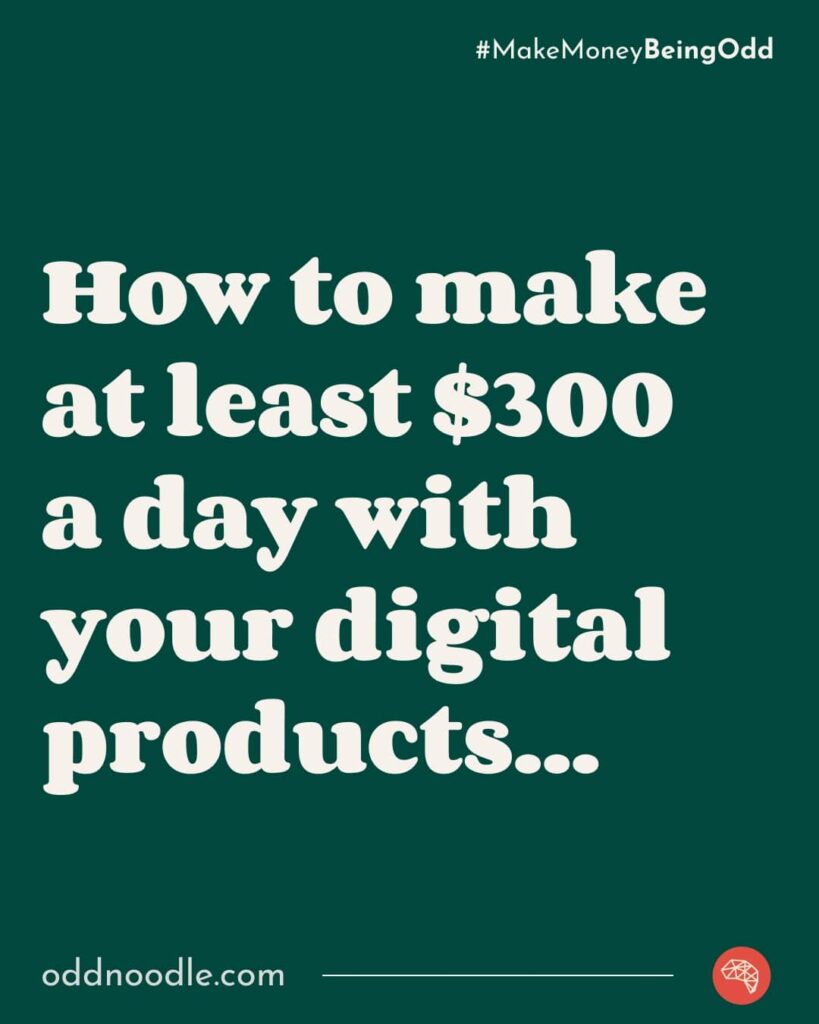Technology has flipped the script on traditional business and entrepreneurship. And we are sooo lucky to be living in a time like this.
As creators and solopreneurs, we can actually create those digital product ideas that are spinning around in our heads in a matter of days. (ok, sometimes in a matter of hours).
Think about it: digital products—those handy e-books, slick online courses, essential software apps, and creative templates—are basically the community courses and night classes our parents took back in the day.
You can’t physically touch them, but you can sell worldwide, thanks to the magic of the internet. No warehouses, no shipping headaches. Just pure, scalable potential.
The cool part? These digital product ideas can reach people across the globe who are looking for help in your speciality and earn you some sweet passive income.
There are so many platforms (Shopify, ConvertKit, etc etc etc) that have made it super simple to get your digital goods out there.
It’s like opening your own store without having to actually build one. This whole shift is seriously empowering us to turn our skills and knowledge into something profitable, all from our living rooms.
Sometimes the hard part is simply deciding which of your many digital product ideas to take action. And that’s what we’re going to figure out in this post.
But first…
Why are digital product ideas a big deal?

First off, they let you scale up like crazy.
Create once, sell a million times—without running out of stock. It’s the dream, right?
Plus, sharing what you know through these products not only earns you money but also cements your rep as an expert in your field. Hello, authority and cool collaboration offers!
Not to mention the fact that you actually get to help people all over the world with your knowledge and skills. That’s pretty amazing.
And let’s not forget the lifestyle perks.
Digital products work for you while you sleep, play, or work on your next big idea. No need to constantly check inventory or deal with shipping.
More freedom, less stress.
Also, dabbling in digital product ideas means you can mix things up. Whether it’s affiliate marketing, catering to niche markets, or creating something unique for the art, writing, or photography crowd, there’s a lot of room to play and profit.
As we dig deeper in this guide, we’ll explore all the ins and outs of finding, creating, validating, and launching your digital product ideas into the world.
Ready to dive into this adventure and unlock the endless possibilities waiting for us?
Let’s get started.
Let’s Talk Digital Product Ideas

Getting a grip on the types of digital product ideas you can create is like finding your compass—it’s what could steer you toward success.
What Are Digital Products Anyway?
Before we get all excited about crafting and selling, let’s nail down what digital products actually are.
Imagine something you can’t hold but can definitely use—like a guide, a course, or an app. These are goodies delivered straight through the internet, cutting out all the hassle of storage and shipping.
It’s all about getting your creation from your brain to their screens with the least friction possible.
Digital products cover a lot, from e-books and online courses to apps and funky templates, right through to music and digital art. They’re usually wrapped up as PDFs, videos, audio files, or other downloadable formats, making it super easy for folks anywhere to get their hands on your work.
The Many Faces of Digital Products

Digital products aren’t a one-size-fits-all; they come in a bunch of shapes and sizes to fit different tastes and needs. Here’s a peek at some of the crowd-pleasers:
E-books: Now when I talk about eBooks, I don’t mean the romance novel you download from Amazon, Ok? In this case, eBooks are things like how to guides, tech tutorials… They are teaching the person that bought the eBook something that will improve their life in some way.
My friend Rachel create an eBook that is basically a how to guide for freezer meal prep. She makes multiple five figures a month from it.
Online Courses: Ever wanted to learn something new from the comfort of your couch? Online courses are the go-to, packed with videos, quizzes, and projects to get those brain cells buzzing. If you’ve got a skill, there’s someone out there eager to learn it.
Here are Odd Noodle we have courses like Full Stack Engine that teach you how to start your own digital product business from scratch!
Workshops: Workshops are great because you can run them live OR you can record it. They are perfect for teaching on particular skill in a short time frame, 1-3 hours, usually.
My friend Danielle ran a live workshop on how to help heal your thyroid. She made 6k when it launched and now she sells the recording of the live workshop.
Memberships: Memberships are an exciting option as a digital product. You create resources for your audience and they pay a monthly fee to have access to those resources!
It’s recurring revenue and that is always a good thing.
My friend Jen created a membership for the homeschooling community she helps and she has courses in the membership they can access as well as new resources added monthly.
Templates: Templates make things move faster and with less stress for people. It can be social media templates, copywriting templates or any number of other things.
My friend Sarah creates templates for making adorable Cricute crafts. They sell like hotcakes!
Why Go Digital with Your Products?

Stepping into the world of digital products gives you a lot of options and opportunities for making money online.
Here’s the lowdown on why crafting these virtual gems could be the best move you’ve ever made:
Sky’s the Limit with Scalability: Imagine selling something that never runs out of stock. That’s the beauty of digital products. Create once, share with a million. Your creations can travel across continents, helping you rake in income while you sleep, travel, or dream up your next big idea.
Keep Those Costs Low: Here’s a sweet deal – launching your digital empire can be super cost-effective. Forget about renting warehouse space or figuring out shipping. It’s all about focusing on creating something amazing, with more of the profits staying in your pocket.
Live Life on Your Terms: This is all about crafting your dream lifestyle. Want to work from a beach in Bali or your cozy home office? Digital products give you that freedom. Pick your niche, set your prices, and create what you love, on your schedule.
Turn Your Smarts into Cash: Got a skill or knowledge that others find baffling or brilliant? Package that genius into a digital product. It’s a fantastic way to share what you know, help others, and establish yourself as the go-to person in your field.
As we wrap our heads around what digital products are and the magic they bring, it’s time to get those creative gears turning.
Up next, we’re diving into brainstorming and fleshing out those digital product ideas.
Kicking Off Your Brainstorm for Digital Product Ideas
Ok, this is the fun part. Coming up with the perfect digital product ideas for you and your audience.
This is where the magic begins, and honestly, it’s all about mixing creativity with strategy. Let’s dig into how you can come up with those brilliant digital product ideas.
Spotlight on Your Superpowers
First up, what are you amazing at?
Everyone’s got something they’re a whiz at—maybe you’re a design ninja, a wizard with words, or you’ve got programming skills that would make Silicon Valley do a double-take.
Pinpointing your talents is step one. This isn’t just about flaunting what you’re good at; it’s about thinking creatively on how to spin your skills into something digitally dope.
If you’re wondering if that thing that is your super power could possibly be something you can turn into a money making digital product, here are some topics people are already making money at:
| Freezer Meal Planning | Fitness Over Forty | Thyroid Healing |
| Cricut SVG Files | Donkey Training | Homeschool Organization |
| Stained Glass Art Creation | Pinterest Growth | Online Business Finance |
| Teaching Music | Homeschool Lit Curriculum | Teaching Day Trading |
| Learn to Knit | Baby Sign Language | Home Care Guides |
Ride the Market Waves
Next, let’s talk trends. Keeping your finger on the pulse of what’s hot and what’s not is crucial.
Dive into your niche and see what’s making waves. What are people buzzing about? What’s missing that you could provide?
This is about seeing where you can fit in and stand out, making sure your digital product isn’t just cool but also in demand.
Be the Problem Solver
Now, think about the headaches and hurdles your potential peeps are facing.
Is there a common gripe you keep hearing? Maybe there’s a gap you’ve noticed that no one is filling?
That’s your golden ticket.
Crafting a digital product that smooths out those wrinkles can make you the go-to guru and seriously simplify lives.
Who’s It For?
Last but not least, picture your dream audience. Who are they? What do they geek out over?
Understanding who you’re creating for is like having a roadmap in this brainstorming expedition.
It’s all about crafting something that not only clicks but also resonates with them on a whole other level.
Making Sure Your Digital Product Idea Hits the Mark

Got an idea you’re excited about? Awesome!
But before you go all in, let’s make sure it’s got legs. Validation is your best friend here, helping you dodge costly missteps and zero in on what will really work.
Here’s how to get the green light:
Dive Deep with Market Research
First, become a bit of a detective. Scour the landscape for similar products and see where they shine or fall short. What’s missing that your product could deliver?
This isn’t just snooping around—it’s about finding your edge. Look into customer reviews, competitor strategies, and even reach out with surveys or interviews.
The goal? Understand your future fans: what they love, what they need, and how you can make their lives better.
Chat Up Potential Customers
There’s no better insight than straight from the horse’s mouth. Engage with folks who might use your product.
Drop into social media groups, forums, or anywhere your target audience hangs out. Share your idea (in broad strokes, to protect your genius, of course) and genuinely listen to their feedback.
This step is gold—it can turn a good idea into a great one, all while building buzz and a sense of community around what you’re creating.
Test the Waters
Before you dive headfirst into development, dip a toe in.
Think about rolling out a Minimum Viable Product (MVP)—a bare-bones version that lets you gather real-world feedback without a massive investment. Beta testing or pilot programs are also smart moves. They offer a sneak peek to a select audience, helping you iron out any kinks and fine-tune the final product.
It’s like a dress rehearsal before the big show.
And ps, an ebook is usually the perfect product for this step!
Iterate and Improve
Validation is not a one-and-done deal. It’s about iterating, refining, and sometimes even going back to the drawing board.
Embrace feedback, good or bad, as it’s all invaluable. This stage is your opportunity to tweak, polish, and ensure your product not only meets but exceeds expectations.
And as you improve your product, the price can go up, too!
It’s Time to Start
As you chart your course through the ever-changing digital landscape, remember that your voyage is one of continuous evolution.
Each new product offering is a chance to learn, to refine, and to better serve your community. The feedback loops you create, the new markets you explore, and the innovative products you launch are all part of a grander journey towards sustainable success and impact.
Embarking on the journey of digital product creation is a thrilling adventure for creators and solopreneurs ready to make their mark in the digital world. This guide has illuminated the path, from conceptualizing innovative digital product ideas to launching them into the marketplace, and beyond into the realms of continuous improvement and expansion.
Dive in, explore, and let the world of digital product creation unlock your full potential.
The future is bright, and it’s yours to shape.

